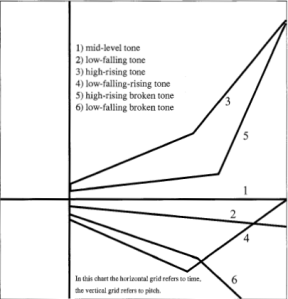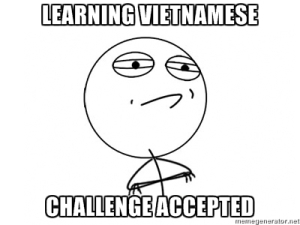Day two has come and gone and I feel as though I am making steady progress. Originally I wanted to spend a fair amount of time acquainting myself with the wide range of phonetics, labialization, and tones, but I feel as though even two or three extra days would cut into the total amount of progress I could ultimately make. I finished reading, listening, and repeating the rest of the consonants, nuclear vowels, as well as learning about the differences in pronunciation between northern (Hanoi) dialect and southern (Saigon/Ho Chi Minh) dialect. At the moment it appears that there are only a few consonants in the northern dialect that are not differentiated between like they are in the southern side of the country.
For example:
The alveolar voiced fricative consonant [z] (voiced similar to the Z in zebra) is contained within both dialects, however the retroflex voiced fricative consonant [Z] (voiced as the G in genre) is not differentiated in the northern dialect. To make matters worse the first is romanized ad a ‘d’ while the latter is written as a ‘r’. While this is by no means ‘abstract’, its obviously something that will take time to adjust to as an English speaker far to used to the phonetic assignments of the English alphabet.
A similar lack in distinction of consonants is found in two other instances:
- Ch (Palatal voiceless stop consonant) In both northern and southern dialects.
- Tr (Retroflex voiceless stop consonant) Is only found in the southern dialects.
as well as - S (Alveolar voiceless fricative consonant)
- ʂ (Retroflex voiceless fricative consonant) This does not exist in northern (Hanoi) dialect.
The tones thus far dont appear to be too daunting, although this could also be attributed to my overall ignorance to the many nuances of the language. Hubris aside, this along side recognition and correct pronunciation of the monophthongs will arguably be my biggest difficult based upon my language experiences in the past. The younger more naiive Pajan who taught himself Mandarin and then unsuccessfully Cantonese would brush off this important characteristic of the language, but the tones themselves are more important than the ability to pronounce a word exactly like a native. (The understanding of prosody is key)
I skimmed through the first lesson to see what the overall format was like and it did not seem far off from any regular text book. I listened to the dialogues a few times and attempted to repeat with the tracking despite what seemed to be the lightning pronunciation of the voice actors. After six or seven listens, however, I was able to properly follow along and mimic the dialogues which is amazing given my limited exposure to the language.
There doesnt seem to be a great deal grammatically that is out of the ordinary either. The basic subject + predicate structure seems indicative of most modern languages. The features of question particles and SOV sentence patterns are relative given my exposure to Altaic, Sino-Tibetian, and Indo-European languages. I can say that I am most grateful for the lack of conjugations. Verb conjugation is a vital part of understanding many languages, however it can also be a great source of frustration especially if the systems are not ‘intuitive’ or based upon a simple system.
My goal for day three is to listen to the dialogues of lesson one, begin to memorize the vocabulary, and dive deeper into the syntactic structure.
Also im sorry if there are sporadic mistakes, or sentences that dont make sense. Its amazing that im doing this given my schedule and the only time I can find to study and report is about 2AM PST everyday.
Cheers,
Pajan

